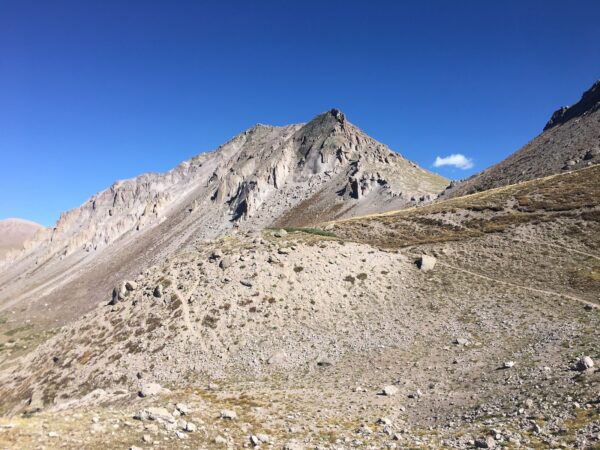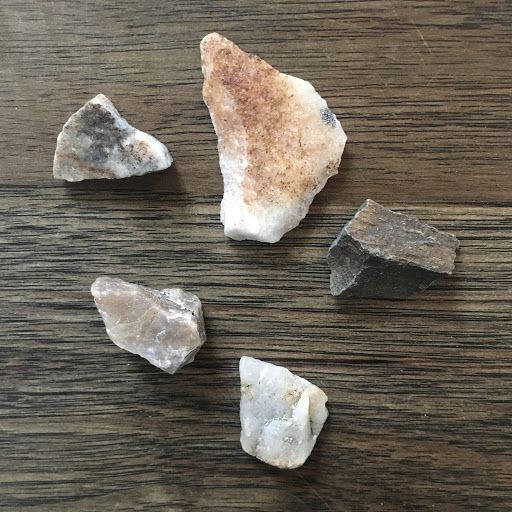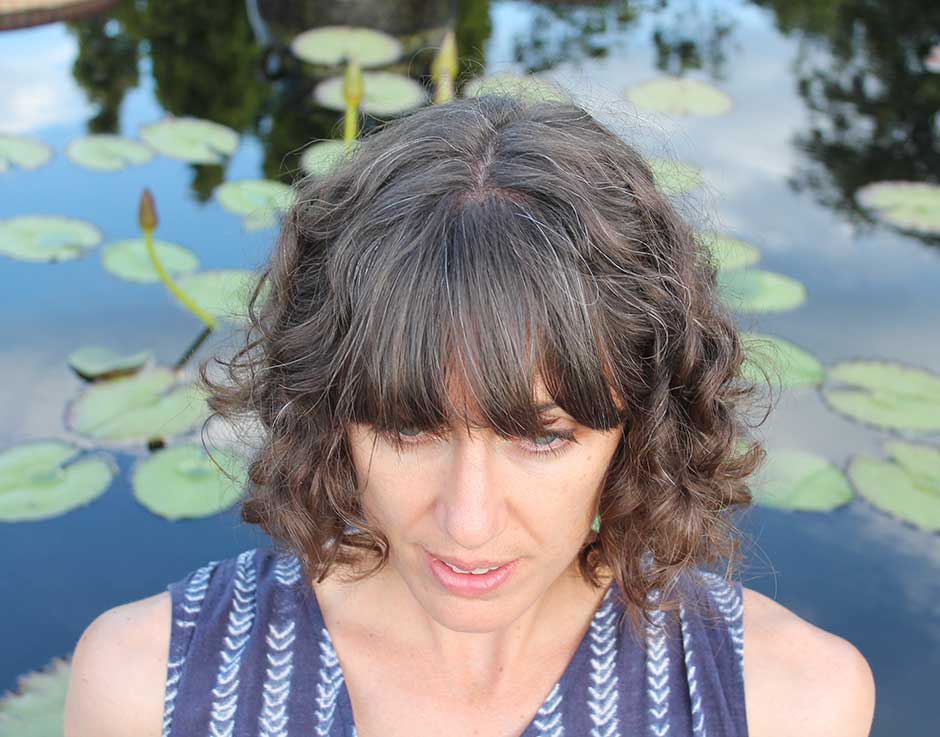Kelly Krumrie’s figuring
Five Small Rocks
Figuring is a monthly column that puzzles over (to figure) and gives shape to (a figure) writing, art, and environments that integrate or concern mathematics and the sciences. This month’s column meditates on rocks and the imprint nature leaves on human beings.
Kelly Krumrie’s figuring
Five Small Rocks
Figuring is a monthly column that puzzles over (to figure) and gives shape to (a figure) writing, art, and environments that integrate or concern mathematics and the sciences.

Last week, after several wildfire smoke postponements, my husband and I spent a week backpacking in southwest Colorado. We camped near a lake for two nights, and on the day between, we hiked a loop across the continental divide—over one pass (at 12,500ft above sea level) then down to about 11,000ft, and then up to another pass (at 13,100ft), down to 11 again, and back up over another pass (at 12,400ft)—that ended up taking nine hours because we kept getting lost. The good thing about losing your way so high up is you can kind of see where you’re going. There are peaks and ridgelines, few choices. The bad things are many: we were on the other side of what Colorado people might call an “epic” peak, it was getting later in the afternoon, we had only rain jackets and a handful of trail mix, increasingly tired, there was wind, incoming freezing night temperatures, etc.
It ended up fine. We made our way through a saddle and down a bare slope, breaking from the faint trail in a few places, sliding sideways down sandy patches, back up through a pine forest to our campsite at the lake as the sun set, etc., okay.
Before we kept losing the trail—something pretty unusual for both of us, I’d say; we do this kind of thing fairly often—on the second pass over the continental divide, I picked up five small rocks. Two I hardly stopped for. This was off the trail; we climbed up over a little bump to get a better view. One rock on the way to this view, one on the way back—I spotted them, scooped, and put them in my pocket. The other three I looked for, squatting down and peering at the high alpine grasses and lichen, little flowers, and so on up there, gnawing on dried mango, while Josh pointed out peaks and ridgelines he’d ridden his mountain bike over. I joked that I was like a child filling my pockets with small things.
I said something like, Think how strange it would be to be a rock, how long you’d be one, how compact.
In The Materiality of Stone, Christopher Tilley writes,
But the context of a stone is not simply its spatial background or horizon. It always involves time as well. The backgrounds of a thing are constituted out of a whole network of past experiences and future expectations which are not, in any empirical sense, part of our immediate sensory fields. Thus the invisible aspects of a stone are as essential in its meaning and significance as those that are visible… [Stones] are always more than themselves: in a process of becoming rather than a static state of being.
Like a child and with children, a few years ago, I picked through and gathered dozens of tiny stones in a tidepool on Catalina Island. I took a group of seventh and eighth graders there to a marine biology camp. And in the tidepools they kept finding bits of sea glass. They leapt around the beach holding up little green, yellow, blue objects that really are trash. Broken glass tumbled for many years, yes; though they’re pretty, surely. One student found a clump of black and exclaimed, Is this pitch?! thinking of tar used to seal wooden boats, something she probably read about in a novel. Our guide explained that it was likely crude oil that had been tumbled into a smooth solid, like the glass.
As Josh and I drove to the mountains last week, we listened to a Radiolab episode on the day the dinosaurs died. Whatever particles (I can’t remember) shot up into the air and into space from the asteroid impact formed tiny glass orbs that then rained down on the earth, some disintegrating along the way, but others hitting land and water (and dinosaurs, plants, other animals). The little orbs now may be sealed up in rock, mud-fossils, I don’t know what, even from that long ago. But how horrifying: raining sharp perfect spheres. I imagine them piling up like sparkling hailstones.
On the way home from Catalina Island, the children and I became separated in the security line at LAX. We mazed through different busy lines and vowed to meet at the other side. When I made it out, last, one ran up to tell me that TSA had a boy in the little room. When I found him, they did have him there, splayed, and they were patting him down. The TSA person told me they found seashells, rocks, and sand in his bag—what he had collected from the tidepools. His hands lit up the body scanner like sparklers. We were at a marine biology camp, I explained. The night before, we snorkeled among bioluminescent phytoplankton. Was it phytoplankton on his hands? He was in trouble for this?
My brother and I tease our mother often about the time she brought home a couple of softball-sized, black, jagged stones from a national park (not allowed) to create a scene with a carved wooden bear and some pine cones in our downstairs bathroom. This woman is stealing rocks! we shouted in the trailhead parking lot.
The five small rocks I picked up along the continental divide all have a similar shape. I see this now that I’m home. They’re kind of trapezoidal, each of them. Three similar in color; four about the same size. Some of the granite up there is so pink, I was trying to bring a little back. In The Materiality of Stone, Tilley mostly writes about monoliths, giant stones ancient peoples moved and arranged. About each stone or group of stones, he wonders,
1. Was it the shape, surface texture, colour, intrinsic characteristics such as cracks or fissure lines of the rock that were of significance?
2. Was it the particular relationship of the rock to others in the surrounding landscape that made it important? Was a carved rock significant, not in isolation but only in relation to others with their own specific forms and characteristics in the immediate area surrounding it? …
4. … Can one see from one carved rock to another? How easy is it to approach a carved rock? What other kinds of rocks (carved or uncarved) does one have to pass, or clamber over, to reach it?
I clambered far for these, and the sea glass clambered itself into being and the children for it. Those dinosaur orbs seemed to form in an instant; the mountain I was on so long.
Why do we want to take them home? These five rocks are now sitting on my desk for what? I should take none, have none—not even the littlest form of environmental extraction? If I don’t have to, especially from tidepools? I have more rocks on my desk: a long charcoal-colored rectangle I spotted on a trail run, a piece of green marble from western Ireland, and a crystal my mother gave me when I was a teenager, probably around the time I tried to get her in trouble for taking rocks.

During my backpacking trip’s postponement, I read Clark Coolidge’s The Crystal Text, where each day he meditates on and writes a short poem about the crystal sitting on his desk. I loved it more than anything I’ve loved in a while. The poems accumulate, only a small dot to separate one from the next. They pile up next to each other across the pages like refractions of the object itself: edges, transparency, imperfection, flatness and angle, hardness, order.
But, as Tilley writes, stones are also always about time, their invisible processes, and I suppose this includes experience and memory for whoever’s looking at them or setting them on desks, gathering while lost on frightening peaks, which feels a little silly to me, or sentimental, I guess. Though I did feel scared on the mountain and when the TSA held my student. I do wonder at the tidepool, am in awe of how glass forms. I hate that spilled oil is tumbling in the ocean. Connemara was so wet and so green. This is what’s in the rocks I’ve gathered up, or what’s around them? What I am extracting?
These five rocks are not as striking as Coolidge’s crystal, what I imagine that crystal to look like. Instead of describing the crystal over and over, he kind of writes around it. Tilley writes that there’s no end to looking at a rock. Looking around and writing around one can make it more extraordinary—even when the rock is out of its element on a desk. I dip in and out of the edges of the crystal poems like moving through landscape or memory? My eyes on pebbles or monoliths? Coolidge writes of the crystal,
It makes me upset, it makes me upset
best is all.
The point of it all is that everything
is important, not just

About the Author
Kelly Krumrie‘s prose, poetry, and reviews are forthcoming from or appear in Entropy, La Vague, Black Warrior Review, Full Stop, and elsewhere. She is a PhD candidate in Creative Writing at the University of Denver where she serves as the prose editor for Denver Quarterly.